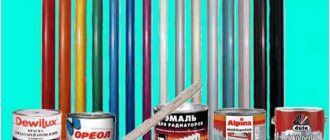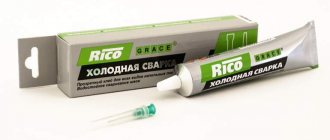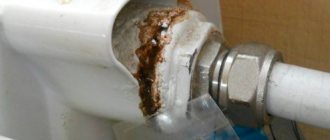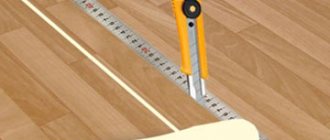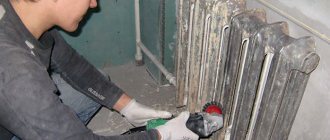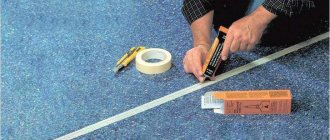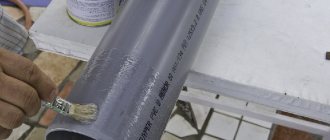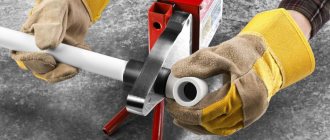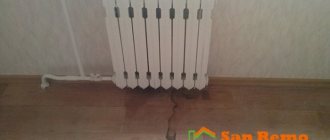Cold welding is a fairly universal way to repair various metal products, especially if such repairs need to be carried out quickly and the product must be put back into operation in a short time. Cases with pipes and heating radiators are no exception when they unexpectedly leak. In this case, cold welding can be a good help when performing repair work during a period when the heating season is not over, or when there is a need to urgently carry out repairs with virtually no interruption in the heating process of a residential or non-residential premises.
Currently, there are quite a large number of different options for cold welding, which can be used for different types of materials. In its appearance, cold welding is a special adhesive composition, which may contain various impurities or fillers, depending on the types of metals that will be joined using this composition.
Cold welding - what is it, application for heating system
The technology of gluing metals has been used since ancient times; as a result, permanent connections were created without the risk of oxidation of parts. Cold welding is understood as a technological process of joining products without additional heating, as a result of which their surfaces undergo plastic deformation. The latter destroys the film of oxides, which previously prevented the metals from joining. Welding occurs in a short period of time as a result of setting. In appearance, this adhesive composition resembles putty and is made on the basis of epoxy resin.
Cold welding is now widely used to join the following metals:
Using welding glue, you can repair steel and aluminum batteries, cast iron radiators, and bimetallic radiators. Polymer products for pipelines can also be welded in this way. We are talking about propylene pipes, which are used for installing a heating system. If the technology is strictly followed, it is possible to seal a pipe, riser, or radiator with any defect, although the strength of the joint will be somewhat inferior to that after electric arc welding.
Top 2. ASTROhim heat-resistant Total Bond AC-9315
Rating (2021): 4.41
Better thermal stability of the connection Cold welding ASTROhim Total Bond can withstand heating up to +250˚C. This is the best rating indicator.
- Characteristics
Average price: 120 rub.
- Country Russia
- Weight: 55 g
- Curing time: 180 min.
- Temperature resistance: -60…+250˚C
- Number of components: 2
For hermetically sealed gluing and restoration of parts made of ceramics and various types of metals, two-component Total Bond adhesive is suitable. High resistance to maximum temperatures in the range of -60...+250˚C allows the use of this composition in automotive applications. Cold welding is also effective in assemblies operating under load. After preparing the compound, the plasticity of the adhesive mass allows you to recreate even a threaded connection. The disadvantage is the need to fix the applied layer for several hours, but the strength gained over time evokes sincere respect among the owners.
Advantages and disadvantages
- Affordable price
- Excellent heat resistance
- Connection strength
- Requires fixation before hardening
See also:
- 15 best liquid nails
Cold welding composition
Adhesive for metal and plastic is made from epoxy resin, a polymer with high strength characteristics. It is this resin that is responsible for the homogeneity, plasticity of the mass, the ability to seal even minimal cracks and fill holes. Epoxy can thicken only when in contact with the hardener that comes with the kit (in some products it is in solid form and is activated after exposure to air and mixing).
Cold welding contains various fillers that optimize technical properties: steel powder (strengthening additive), sulfur, plasticizers. When repairing radiators, you must definitely pay attention to such additives; they must be in the putty.
Preventing the problem from recurring
It is easier to prevent problems in the heating circuit than to suddenly look for ways to eliminate them. So before the start of the heating season, communications are checked by testing, especially focusing on dangerous areas.
These include:
- level spans;
- threaded connections and welds;
- zone of joining sections at radiators;
- places of implantation of heating equipment;
- near fittings;
- hard-to-reach areas.
First, everything is checked by eye, then with the circuit running.
Types of welding
All products belonging to this type are divided into plastic and fluid. The latter are necessarily two-component mixtures - one bottle contains epoxy resin with additives, the second contains a hardener. Plastic masses are sold in tubes, bottles, jars; they can be used to coat a pipe or radiator without dilution. The mass looks like plasticine, consisting of two blocks that need to be mixed together by kneading with your fingers. It is possible to separate a small piece of the mass and save the rest until the next need.
Methods of use
To repair pipes, you need to prepare everything you need - the welding agent itself, acetone or alcohol, sandpaper, rags and clamps. The method of sealing radiators varies somewhat depending on the type of welding - liquid or plastic. It is important to choose a suitable product that is suitable for pipes under pressure (metal or polypropylene). Next, you need to prepare and mix the material, and you should work faster with liquid products.
Welding application methods:
- simply sealing the defect with a piece of mass, flattened and kneaded with your fingers;
- the use of special fiberglass fabrics, threads for wetting with epoxy, followed by wrapping with rubber, wire or without it;
- gluing onto a large defect covered with a metal patch.
If the leak is strong, you can make the composition even more durable with your own hands. You need to take any aluminum or bronze part, grind it a little over paper, obtaining metal powder. It needs to be added to the epoxy mixture, which is then used to saturate the turns of thread or fabric.
Temperature indicators of the mixture
Depending on the exact composition and specific manufacturer, the temperature range of welding applications can vary greatly. Most products can withstand freezing, for example, Mastix glue will not lose its properties even at -60 degrees. The overwhelming majority of cheap epoxies only work up to +150 degrees, so they can be used for welding radiators and heating pipes (heating networks usually operate at +95...+110 degrees).
Better quality products can withstand up to +260 degrees, but there are also high-temperature mixtures - they are used even in extreme conditions (up to +1300 degrees). Although there is no point in spending money on purchasing such products, you can buy a simple low-temperature composition.
Review of the best brands
In all ratings of adhesives for PVC pipes, the leading brands are Tangit (Germany), Genova (USA), Griffon (Netherlands), Gebsoplast (France). Buyers speak well of the adhesives “Phoenix” , “Vinilit”, “Mars” and others, but they are not so in demand and popular.
All types of glue for polymer pipes operate on the same principle, are available in packages of various sizes, and the appropriate composition should be selected depending on the purpose and technical characteristics.
Advantages and disadvantages
The technology allows you to eliminate pipe leaks with high reliability. This procedure is safe to perform, which cannot be said about conventional welding. Other benefits are:
- convenience, ease of the technique even for beginners;
- excellent seam quality, which depends mainly on the type of material, and not on the speed of work;
- no need to purchase special tools, equipment, machinery and expensive materials;
- minimum energy consumption;
- fire, anti-explosion properties of epoxy;
- low cost of repairs;
- Availability of cold welding - adhesives are sold in any store.
The technology also has disadvantages. Welding of this type is not designed for too high loads - pressure, high heat. Therefore, if there is a serious defect in a pipe or radiator, it is better to use hot welding or replace the area completely. It is important to follow the preparation measures - otherwise the quality of the weld will decrease. The durability of cold welding is lower than that of standard welding - repaired pipes will not last for many years, but will require new repairs. In fact, such repairs are considered by specialists to be a temporary measure.
Types and manufacturers
Typically, cold welding is used when it is not financially feasible to use the hot method or it is difficult. Such situations occur when a minimal defect appears, damage to a dimensional product, or the risk of serious internal stresses in the pipe.
The following types of products can be used for repairs:
- universal – used for gluing metal, plastic, stone, wood, glass, concrete and most other materials;
- automotive - if the material indicates that it can withstand high temperatures, then it is allowed to be used in pipe repair;
- for plastic - usually the heat resistance of such products reaches +260 degrees and above, so they are also suitable for work.
Products marked “for wood” or “for plumbing” are not suitable. They, as a rule, are not heat-resistant, and the quality of adhesion will be lower. It is better to find a specific welding method for working on metal or plastic with a clear indication of the temperature conditions. There are even super waterproof products for working underwater, which can also be used for cold welding.
Domestic formulations are cheaper than imported ones, but are not inferior in quality to the latter. Just don’t take the cheapest welding, it will certainly produce a low quality weld. The most popular means are:
- Hi-Gear. A universal adhesive, it is often purchased by car owners to seal elements subject to heavy loads. This glue will help eliminate any leaks in the heating system.
- "Titanium". Suitable for any materials, does not deteriorate from exposure to water and high temperatures.
Specifications
This product has a number of characteristic features that are determined by its characteristics. Of course, each brand may have its own characteristics, but in most cases the characteristics look like this:
| Primary drying time, minutes | Complete drying time, hours | Minimum operating temperature limit, degrees Celsius | Maximum operating temperature limit, degrees Celsius | Package volume, grams |
| 30 | 5 | -40 | +300 | 57/115 |
If high-temperature cold welding is used for aluminum, then its upper limit can be above 700-100 degrees Celsius. Some additional substances that are added to the composition can also change the characteristics, but they are often narrowly targeted and not so common.
Cold Welding Selection
Selecting the right brand largely determines the quality of the subsequent repair operation. To do this, you need to pay attention to certain parameters that are important to you. Here you need to find a balance between price and quality, since trusted manufacturers can offer quite expensive products
First of all, you need to pay attention to the temperature conditions in which the material can be used. It must match or exceed the one in which you will work
Next, you should pay attention to what surfaces you can interact with. After all, there are compounds intended only for aluminum, but there are also universal ones
"Note! Here we should not forget about the presence of a metal filler made of aluminum. The fact is that some universal compositions, which are also suitable for aluminum, may not contain this metal, although they glue it together.
The container capacity matters if you use this substance frequently. Everything is simple here, since the more material there is in it, the relatively cheaper it costs per unit of weight. The packaging should be convenient for storage and transportation, because it is often necessary to use cold welding for repairs on the road and away. If there is often a need for urgent repairs, then the substance should have a quick drying period. This parameter may differ several times between different brands.
Features of application
Full instructions for use of each variety are written on the packaging, but this type has a number of its own features that you need to know, regardless of the brand presented.
- First of all, when cold welding for aluminum is used at home or at work, all procedures should be carried out using special protective gloves. The possibility of skin contact with the material should be avoided as much as possible.
- The surface on which work is being carried out must be degreased and cleaned of debris, plaque and other unnecessary things. Otherwise, the quality of the connection will deteriorate.
- When preparing the mixture, it is advisable to use non-metallic objects, including containers. If the adhesive is intended for adhesion of metal parts, then on such surfaces it will interact less even before direct use.
Application of Cold Welding for Aluminum
Manufacturers and popular brands
It’s worth familiarizing yourself with the types of cold welding on aluminum to make the right choice.
- Mastix (Russia);
- Weicon;
- Permatex;
- Loctite;
- Poxipol;
- Devcon.
Instructions for cold pipe welding
First you need to properly prepare the base. To do this, all areas to which the resin will be applied are cleaned of rust, dirt, and old paint. You can sand them down to immediately remove all dirt. You should not try too hard, otherwise deep scratches will remain on the surface. But small abrasions will come in handy - they will enhance adhesion. Immediately before welding, parts must be degreased with a solvent (usually acetone) or washed with detergent. If possible, you need to dry the joints with a hair dryer - heating will improve adhesion.
The glue is prepared depending on the instructions. To produce a liquid adhesive composition, a strictly measured amount of hardener is added to the resin. The lifetime of the composition is also indicated in the instructions, then its polymerization begins. Usually the period is 10-15 minutes or a little more. This time can be slightly extended by cooling the product.
Plasticine-like mastics are prepared by kneading with your hands, after putting on gloves and wetting them with water. The required amount of material should be cut from the rod and the rest should be removed. You only need to cut strictly across, otherwise the ratio of epoxy and hardener will be incorrect. When ready, the color of the mass will become uniform, and it will heat up due to the release of heat.
Repairs are carried out as follows:
- apply glue to the future joint, directly into the hole, to ensure the mass penetrates deeper;
- the second option is to wind glass fiber or fiberglass, cover it with a liquid composition that has already begun to thicken a little;
- smooth the outside of the product with a small spatula or other flat device, slightly moistening it in water;
- within a few minutes you can change the position of the mixture;
- if the hole is too large, you will have to put a metal patch on it (directly using cold welding);
- fix the area for 15-60 minutes, depending on the instructions, using a clamp;
- If possible, the joint should not be subjected to intense loads for 1-24 hours, although 1-1.5 hours is sufficient for most welds.
If the repair is carried out in a room with a low temperature, the glue should be rolled into a ball and the mass inside should be allowed to warm up to +40...+50 degrees. The holding time of the ball should not be longer than the life time of the mixture (usually it is not kept for more than 4 minutes). To effectively heat the ball, it must be made with a mass of at least 50 g. It must be remembered that when repairing complex joints and assemblies, it is better to immediately use hot welding or replace parts; a cold joint may turn out to be unreliable.
Security measures
After drying, the material is safe for humans, but care must be taken when working with it. All work is carried out with gloves, avoiding direct contact of the epoxy with the skin. Do not use a food grade knife to cut resin. When contacting the mass, the skin is washed with soap and water.
Top 5. Linocol Bostik
Rating (2021): 4.07
Best hardening speed Cold welding for PVC Linocol Bostik hardens within a minute after application - this is the best indicator in the rating.
- Characteristics
Average price: 290 rub.
- Country: France
- Weight: 60 g
- Curing time: 1 min.
- Temperature resistance: +5…+35˚C
- Number of components: 1
One-component cold welding for rubber and polyvinyl chloride products (pipes, linoleum, etc.) reacts with the surface being treated and transforms the joint into a homogeneous area within one minute. Polymerization of the seam eliminates the passage of moisture - this is one of the best compounds for sealing and connecting PVC pipelines. A convenient needle attachment for careful application is very useful - if glue gets on the decorative surface of the linoleum, it will not be possible to remove it. After a quarter of an hour, the treated area is ready for work. Among the shortcomings, the owners indicate only a pungent odor (disappears after hardening) and the high cost of Linokol.
Advantages and disadvantages
- Best setting speed
- Moisture resistance
- Strong odor before drying
Repairing cast iron and other types of radiators
Working with radiators is similar to sealing defects on pipes. The surface is cleaned and degreased. You can use alcohol for this purpose, applying it with a cotton swab. Next, take a ball of resin approximately 2 cm in diameter, knead it, mixing the components. Press the resin to the damaged area, smooth it out, and hold it with a rag or clamp.
Usually 30-40 minutes are enough for polymerization, but it is better to use the battery after a day, not earlier. Naturally, the water supply must be turned off before repairs. If you need to remove a fistula, you need to take fiberglass and a liquid solution, wrap the area and seal it securely.
Cold welding is an excellent temporary measure until the end of the heating season. It will help eliminate pipe or radiator leaks quickly and without hassle!
A leak in a hot pipe or radiator is a nuisance, but a leak that starts in a pressurized circuit is an even bigger problem. If a heating pipe is leaking, the problem must be repaired urgently.
Methods for sealing a leak depend on where it occurs:
- A seamless or welded heating pipe is leaking;
- A leak has appeared at the interface between pipe and battery, pipe and fitting, fitting and fitting;
- In the intersection space of the radiator;
- In an open area of the battery that is accessible for repair.
Each of these accidents can be eliminated using available means and in different ways, but only in one case - if the leak in the heating radiator or in the pipe is small, and water or coolant flows in a thin stream or drips. More serious leaks can be eliminated using more radical methods, which we will talk about. Anyone who has ever repaired a leak in their heating system knows how much trouble they saved themselves and their family from.
In both large and small leaks, you must immediately turn off the shut-off valve for supplying working fluid to the system. The problem is solved by using the following options:
- If the radiator is leaking, then you need to close the shut-off valves at the inlet and outlet of the device. If the radiator has a bypass, then the entire system will continue to operate without stopping; if there is no bypass, then it is better to turn off the boiler to avoid unexpected overheating of the heating system;
- If there are no shut-off valves or they are installed, but not where needed, then the heating must be stopped so that the pipes do not remain under pressure, and the leak must be repaired.
Steel pipes with hot water quickly rust, even if they are painted, and this causes thinning of the pipe walls. In the thinnest places, a leak may appear over time and, if it is not eliminated in time, the drops will imperceptibly turn into a trickle.
If a colored spot appears on the pipe, the paint begins to swell, traces of rusty water drips or rust on the pipe are visible, water is dripping imperceptibly, you should not wait in the hope that it will stop on its own. It is better if you find a suspicious place in the summer, with the heating turned off - there will be fewer problems with turning it off and maintaining the temperature in the room during repairs.
Is it even possible to do this?
It is quite possible to patch up a pressure pipe that unexpectedly leaks on your own using improvised means.
Heat loss calculator
Calculator for the number of radiator sections
Heated floor calculator
The only caveat is if the leak is insignificant , and the water oozes slightly, and does not gush in an endless stream.
When the accident is more serious, you will need to urgently tighten the valve that controls the water supply to the coolant, and then call a repair service.
How to fix a leak in a pressurized water pipe
- If a pipe is leaking when the coolant pressure is low, then an ordinary iron pipe clamp to eliminate the leak is a sure and quick solution to eliminating a leak in the heating system. The factory clamp is a round metal structure with a wall thickness of 1-1.5 mm, rubberized on the inside and equipped with a bolt and a nut for tightening (or a pair - depending on the width of the clamp);
- People's advice on how to seal a leak if there is no steel clamp: wrap the accident site with rubber from a bicycle tube, a pharmaceutical bandage, or any suitable piece of rubber, for example, a rubber glove. You can secure such a homemade clamp with wire, or wrap it with any cord;
- In the absence of a factory clamp and rubber, you can make a homemade clamp from tin, even from a tin can lid;
- Even a piece of elastic polymer (for example, vulcan rubber), tightly wrapped with wire, turn to turn, can temporarily save the situation.
Other methods of eliminating an accident if a heating pipe is leaking will not work - only dry surfaces can be sealed with cold welding, although the hardened composite can then work even in water. It will not work to seal a hole or crack with sealing compounds for the same reason - the surface to be repaired must be dry, and preferably clean. Therefore, sealant for heating pipes, epoxy resin, dichloroethane and other fast-hardening composites are used only on disconnected dry sections of the heating route. This also applies to the repair of the water supply line in the water supply pipe for hot water supply or hot water supply.
How to fix a leak in your home heating system
If the leak is strong and a simple clamp cannot be used to close it, the heating circuit with liquid will have to be turned off. It doesn’t matter where the leak is found - on a heating or water supply pipe - eliminating the leak will only be possible by turning off the water supply. A disconnected circuit gives scope for repairs: you can at the same time check the entire route and repair (replace) all suspicious areas.
Let's start with the simplest ways to fix a leak in a heating pipe:
Seal the gap or hole with a fabric (fiberglass) patch liberally coated with epoxy glue. The patches (there should be 2-3 of them) are cut twice as wide as the diameter of the pipe; the length should allow the pipe to be wrapped 5-7 times. The metal around the violation is cleaned with sandpaper, a file or a grinder, the area is well dried, and epoxy resin is applied to it. The fabric can be soaked with glue in advance, or you can coat it as you wind it onto the pipe - whichever is more convenient on the spot. The last fabric layer is not saturated with glue, and the end of the fabric is secured with cord or wire. Epoxy dries on a pipe in different ways: at a temperature of 20 0 C-25 0 C, a few hours are enough; at a temperature below 18 0 C, even a day is not enough.
If you have repaired a central heating pipe, then the system operates under higher pressure than individual heating, and when water is initially supplied to the circuit after the repair, a noticeable water hammer may occur, which can simply rip off the patch. Therefore, the supply valve should be opened slowly, tracking the area with the patch visually.
You can increase the strength of the patch by adding bronze or aluminum powder to the epoxy glue. If you were unable to buy powder, you can make it at home by grinding off the surface of any non-ferrous metal part with a small file or needle file. By adding such powder, you can make not 5-7 turns of fabric, but 2-3, and repairing such an area will become easier and faster.
Factory materials
From ready-made solutions, adhesives and liquids, you can use a heat-resistant, waterproof sealant to seal the leak. Such adhesive compositions are produced specifically for the repair of heating systems. When purchasing, make sure that the word “neutral” is on the label - this means that your glue will not corrode non-ferrous metal and adjacent materials.
Cold welding is also good for eliminating leaks:
- A liquid epoxy substance that is convenient for impregnating fabric patches that are applied to a hole in a water pipe. Some compounds can also work on a wet surface;
- Semi-solid plastic compositions. This cold welding looks like a small piece of plasticine consisting of two different component strips. Knead the plasticine in your hands until the substance becomes plastic (your palms should be wet - moisten them in water), cover the hole in the pipe with a small piece, and spread it over the cleaned surface. It takes 10-15 minutes to harden, after which the patch becomes so hard that it is difficult to take even with a file.
Both liquid and solid cold welding contain toxins, so it is recommended to use rubber gloves when working with it.
Sealing connections on pipes and between radiator sections
If connections at the junction of pipes or fittings are leaking, then, depending on the difference in diameters, you can immediately seal the pipeline with a metal clamp or first wrap rubber in place with a smaller diameter. The rubber band is easily wound even under pressure, stopping severe leakage.
BF-2 glue works well for sealing the threaded connection in the place where tow or FUM tape is wound. The tow is first soaked in alcohol, then coated with glue. The glue dissolved in alcohol impregnates the winding, and after drying it forms a dense waterproof layer.
What else can the winding be impregnated with and what can you wrap the pipe with so that it does not leak: in most cases, ordinary oil-based (not nitro) paint is used. To do this, wrap the tow around the thread, apply the paint with a brush, and after tightening the thread, paint this area 2-3 more times. You can turn on the heating or water supply only after 2-3 days.
If you can’t fix the leak with your own hands, you need to turn off the heating or water supply and redo the threaded connection: completely remove the old winding, clean the threads and degrease them. New tow or FUM tape must be wrapped with preliminary impregnation with sealant or paint.
- When a metal-plastic fitting leaks, it is easier to eliminate a water supply network leak: you can stop the leak by simply tightening the thread. In 90% of cases this helps;
- To stop the leak, the copper circuit only needs to be soldered;
- Propylene pipes on the heating circuit are repaired by replacing the cracked section with a new section of pipe - this requires a special welding machine for welding PP products - there are no other ways to weld propylene.
If you don’t know what to do if there is a leak between battery sections, then the most common repair is replacing the gasket between the radiator elements, or replacing the nipple. To do this, the system is turned off and the failed part is replaced with a new one. There are no other options other than temporary repairs - applying a patch using the method described above. This is a rather complicated process, since aluminum radiators have a very small distance from section to section.
To seal a leak on an aluminum surface between sections, you need to somehow manage to clean hard-to-reach places. To do this, you can use a cable - you need to wrap it around the leak and pull the ends one by one until all the paint is erased. A clean aluminum surface is sealed with epoxy mixed with aluminum powder or by cold welding.
Few people know, but you can coat a heating pipe with regular table salt! A small hole in a water supply line or heating pipe will immediately stop flowing if you rub it with a pinch of salt. If the hole is rather large, then salt is used together with a regular bandage - rewinding the leak area, sprinkle the bandage with salt.
If an aluminum radiator is leaking, then repair is a temporary measure for one season. To get through next winter, the radiator needs to be changed - it will definitely leak in another place.
How to fix a leak on a radiator
Not between sections, not on the threads, but simply on the body of the radiator - such cases occur mainly with cast iron or steel devices due to cavities that occur in the casting. Temporary repairs can be carried out as follows:
- The easiest and fastest way to stop a leak if the hole is small is to hammer a wooden plug (plug) into it. Level it with the surface of the product, cover it with sealant or cold weld;
- In addition to wood, a self-tapping screw or press washer will work well. The hardware also needs to be lubricated with sealant before screwing it into the hole.
Leaking hidden pipes
It is clear that this is the biggest nuisance that can be imagined in a newly renovated apartment. There are two options for how to seal to prevent pipes from leaking in the wall or under the floor:
- If this is a heating route, then add 100 grams of dry mustard to the expansion tank. 2-3 hours are enough for small holes to heal. The next day, you need to drain the mustard water from the system and fill in with new, clean coolant. This is done to prevent the filters in the heating circuit from becoming clogged;
- Mustard is a popular household method, but factory sealants that need to be poured into the coolant to prevent the pipe from leaking also work. The principle is the same - the next day the liquid is drained and replaced with clean one.
Classic high temperature welding
How to weld heating from an iron pipe in accordance with building codes is indicated in GOST. Both the diameter of the pipes and the length of the system matter. SNIP will indicate how to properly weld heating pipes in each specific case: private household, multi-storey building or industrial water supply line.
When using a gas welding machine, creating high-quality seams will require considerable practical experience. Electric welding can also create welded joints of impeccable quality, but in this case you will need not only experience, but also high-quality electrodes, the correct current level and “arc feeling”. High-quality electric welding of heating pipes is available only to real professionals.
Metal pipes are the most common material for heating systems
The strength of metal pipes is more than sufficient for the water supply system and for the heating circuit. It is the connection sections that have to be implemented in order not to deviate from the design documentation that are the “weak link” of the system. How to weld a heating pipe using electric welding is described in detail in outdated training materials and articles. In modern construction, the cold welding method is more often used for heating pipes.
It is important to know! Threaded connections for metal pipes are used in cases where it is necessary to create a detachable connection. The tightness of the connection in this case is guaranteed by a sealant, most often tow.
Every qualified installation engineer knows how to weld a heating pipe correctly. There are a number of rules that must be followed:
- The weld should not consist of scale. This happens if you weld a pipe by electric welding using low-quality electrodes.
- To weld metal with an electric welding machine, it is necessary to use a multilayer metal melt method. Primary weld scale is removed before the next welding layer.
- It is important to choose the correct current level - low current does not guarantee the strength of the weld. Excessively high current during welding is also unacceptable.
- If the butt welding method is used, the electrode metal or molten wire is used as the reinforcing material.
- Electric welding of metal pipelines and other elements of heating and plumbing systems is prohibited near flammable objects.
Gas welding is a universal method for creating a strong connection between metals; metal parts of different sizes can be connected in any combination.
For traditional welding you need to have special equipment and welding experience
The high temperature of the burning gas stream allows you to melt the metal in the area of local heating, and cook the metal at the molecular level. Requires expensive equipment and highly qualified welders.
Top 3. Point H-44
Rating (2021): 4.35
25 reviews taken into account from resources: Wildberries, Ozone
The most accurate application Cold welding Point H-44 has a special needle for application, resulting in a small but no less strong seam when joining butts.
- Characteristics
Average price: 285 rub.
- Country: Poland
- Weight: 100 g
- Curing time: 24 min.
- Temperature resistance: -30…+80˚C
- Number of components: 1
When carrying out interior renovation work, users often choose Point H-44 cold welding. The presented glue helps to organize a high-quality and neat joint when laying linoleum yourself. For maximum efficiency and precision of application, the package includes a hard plastic needle tip. The transparent seam is durable, resistant to moisture and chemical compounds. Most of the reviews about this product are positive; dissatisfaction often occurs when the glue is used for other purposes. They also note that the nozzle is not thin enough.
Advantages and disadvantages
- For rigid PVC
- Elastic seam
- Ease of use
- Needle diameter
